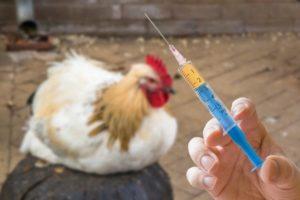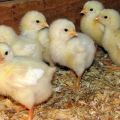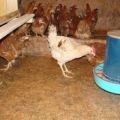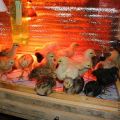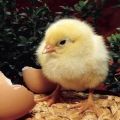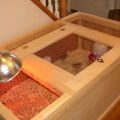10 best methods to independently determine the gender of a chicken
Growing poultry at home is associated with certain nuances. They concern not only compliance with the rules of keeping, but also the characteristics of the bird, age, needs. Those who are going to raise chickens need to understand how to determine the gender of the chicken when buying. The conditions for caring for the bird, as well as the profit of the subsidiary farm, depend on this.
Features of determining the sex of the chicken
Breeders have to separate males from females for various reasons. Chickens that will lay eggs should be placed in separate conditions as early as possible. At birth, all chicks are similar to each other, therefore, different methods are used to determine the sex of the bird.
How to tell a chicken from a cock at different ages
Chicks appear on the poultry farm in one of the following ways:
- after making a purchase;
- after incubation by a hen;
- after hatching in an incubator.
Each of the options has its own advantages and disadvantages for a particular poultry farm. Owners can determine the sex of chicks at different stages of chick growth. Buying means purchasing the chick at a later age, so sex determination methods may vary.
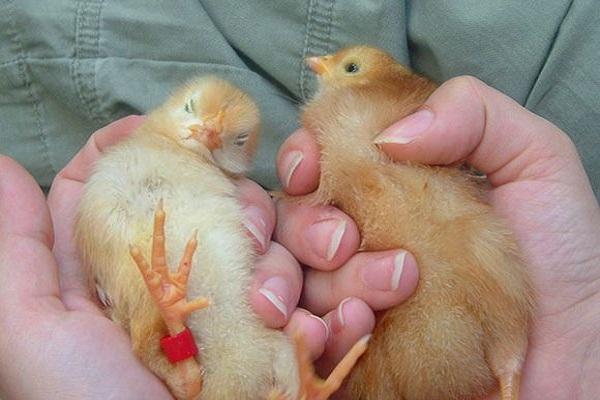
Daily age
A chick that has recently hatched from an egg has no pronounced external differences. The signs by which you can distinguish a cock from a chicken are at the stage of active formation. Day-old chicks are recognized by laboratory, reflex methods.
In addition, there are methods for determining the appearance of the egg, although the error of this method can be high.
Weekly age
Upon reaching the age of one week, sex determination is associated with an assessment of the bird's body size. Males grow larger than females. But you should not focus only on size, because each chick can have structural features.

Monthly age
By the end of the first month of life, visual sex determination becomes more reliable. It should be borne in mind that the error of the visual method is still high.
Monthly hens begin to actively fledge, while males remain naked. For them, body growth remains in the first place, and then plumage begins.
Age 2-4 months
At this stage of development, many experienced poultry breeders distinguish the sex of the chick by behavioral responses.When a poultry farmer tries to get closer to young animals, the birds behave differently:
- the males scatter in different corners of the pen, then try to take a more advantageous position;
- chickens huddle in flocks and snuggle up to each other.

Age from 5 months
At this age, it is quite easy for experienced breeders to distinguish a chicken from a rooster in appearance.
| Hens | Cockerels |
| Only old chickens can have spurs | Massive legs with spurs |
| Neat little combs and earrings | Massive comb, earrings |
Sex determination methods
As a rule, several methods are used to determine the sex of chicks. If it is impossible to carry out laboratory analysis, the floor is determined by the appearance, size and temperature of the eggs.
To size
Chickens differ from roosters in overall size. This becomes noticeable when you reach the age of one month. Day-old chicks are difficult to measure by total volume because many chicks can be born frail and sickly, regardless of gender.
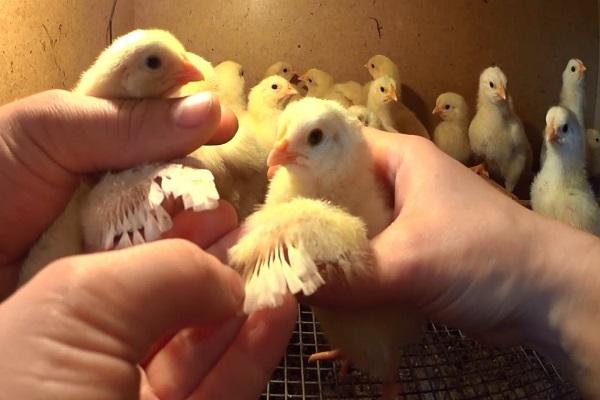
By feathers and wings
This method is used on farms, although its reliability ranges from 60 to 80 percent at the border:
- in cockerels, wide flight wings are formed; when examining the wings, it becomes noticeable that the feathers that make up the wing are long and frequent;
- in chickens, feathers are short and sparse, this is due to the fact that they do not need a wide swing, in the future they will be densely covered with down.
In addition, the plumage can easily determine the sex of some breeds. For example, female chickens of the Brama breed are distinguished by the fact that black dots are clearly visible on their heads.
The Leghorn and Lebar breeds are known for the fact that laying hens after birth have a monochromatic plumage, in cockerels the color is striped. On the second day of life, representatives of the Rhode Island and New Hampshire breeds become variegated, clear spots appear on the head, and stripes appear on the back. Males of these breeds remain the same as at birth.
In Adler silver chicks, sex determination by appearance is particularly simple. The hens become bright yellow, while the cockerels are lemon yellow with a black stripe on the head.
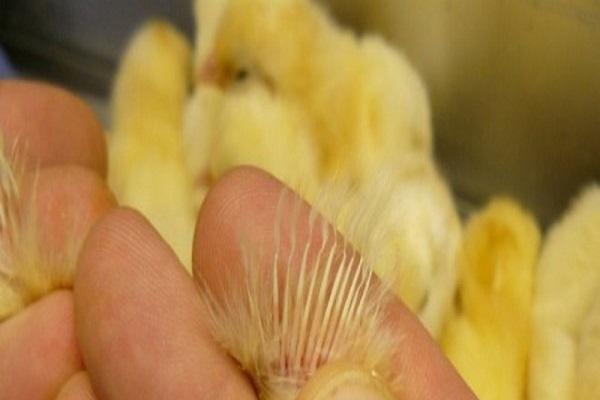
By color
Day-old chicks can be distinguished by color. This is due to the peculiarities of the bird breed. This implies that paternal qualities are transmitted to hens, and maternal - to cockerels.
This method can give 100% results if the owner knows exactly who owns the fact of paternity and motherhood.
Ventsexig or Japanese way
This variant of sex determination is successfully used in poultry factories, its reliability reaches 95 percent. The basis of the method is the difference in the structure of roosters and chickens. The definition depends on the experience and knowledge of the person sorting the chicks.
- The chick is taken in hands and pressed on the stomach, in this way the rectum is freed.
- Then it is turned over and the cloaca is examined.
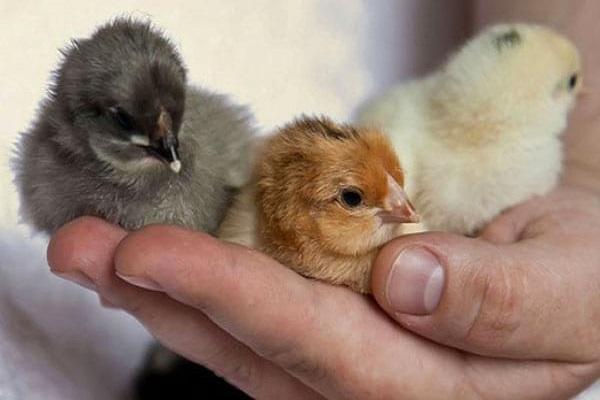
A small protrusion can be observed in the cockerel, this is a feature of the reproductive structure. Chickens do not have this ledge.
Information! The Japanese method is used in poultry farms in Japan. Experts sort up to 700 chickens by this method within 1 hour.
Reflex Behavioral Mode
This method of determination is often referred to as the "grandmother's way". The chick is turned upside down. At the same time, the males lower their heads down along the body line, and the chickens begin to retract their heads.
The reaction is explained by the fact that the males are initially set up to accept the situation and search for possible options for the development of events, and the hens are trying to group up and protect themselves from possible external influences.
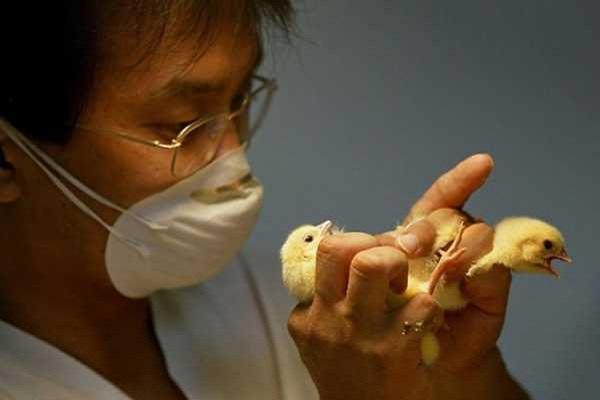
Over the egg
Some poultry farmers have learned to determine sex by the structure of the egg. The basis of the method is that the sharp tip of the egg indicates male sex. This option is considered the least reliable.
There is a method for determining with an ovoscope. It is turned on, the egg is placed on the surface of the cell, translucent. If the air chamber is located strictly in the center, then the egg contains the future cockerel. When the air chamber is tilted to one side, there is a high probability of a chicken appearing.
Warning! Gender recognition by size and other features of the egg is only possible if the eggs are laid by one hen.
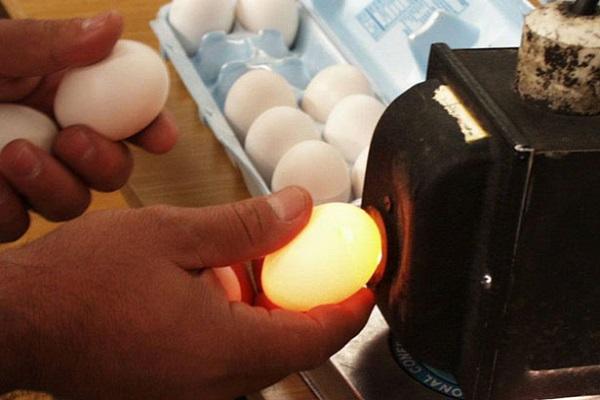
By gait
The gait of heterosexual chicks differs in several ways:
- paws of males are more massive and longer, females have shorter and more graceful paws;
- the step of the hens is rhythmic, the males walk wider.
Body size can also affect gait. When they reach the age of one month, males become larger than females, so their step becomes wider.
Scientific methods
There are precise laboratory methods that can help determine gender with high accuracy. For this, special devices are used, which are rarely used in small poultry farms due to the high cost of conducting analyzes.
Cytogenetic method
The basis of the method is counting and studying the chromosome set of each chick. This option allows you to confidently determine the sex of the bird on the second day of existence. In males, a variety of one of the chromosomes is represented by the majority, in females - by a minority. The study lasts from 2 to 4 days. The results can be formulated by technologists who have specialized knowledge.
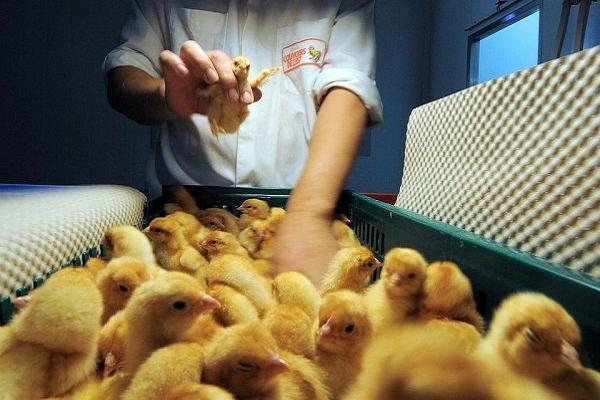
Information! The cytogenetic method helps to determine the sex with one hundred percent accuracy.
Blood test
To determine the sex, a blood test is taken from day-old chicks. This analysis is 100 percent reliable, but can be stressful for chicks as well as costly for owners.
To determine gender, DNA tests are performed, which require a certain amount of fresh blood. For research take "washed" erythrocytes.
Folk ways
Over a long period, when poultry farming developed independently, before it was formed into a separate branch of agriculture, on the territory of small subsidiary farms, poultry farmers learned to use folk methods for determining the sex of poultry.
Among folk methods, behavioral methods and methods of determining by external signs are distinguished:
- On the first day of existence, the plumage of cockerel chickens is lighter than that of hens. Later it flattens out.
- If you lift the chick by the scruff of the neck, the hens will begin to pull their legs to the body, group, and the males will look around, looking for the cause of the inconvenience.
- After the onset of one month of age, roosters are determined by behavior: they are prone to fights and bullying other chicks.
- By the egg, the floor is recognized by a simple touch. If a roughness can be felt at the pointed end, then a male should be expected.
- According to the observations of experienced farmers, chickens feather more actively, the feather in the first stages becomes fluffy and silky, in contrast to the rooster's plumage.
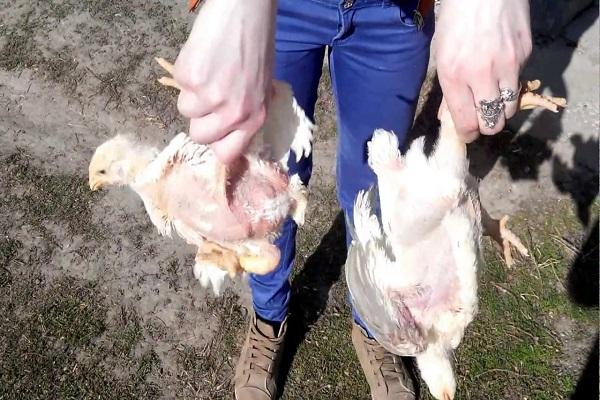
Why determine the sex of chicks
Many aspects of poultry farming depend on sex determination. When buying chickens, poultry farmers are guided by the main directions:
- cockerels are bought to be raised for meat;
- chickens are chosen for obtaining eggs, their further marketing.
Sometimes the continued existence of the farm depends on sex determination, so choosing the appropriate sex determination method for poultry farmers becomes one of the main tasks.

